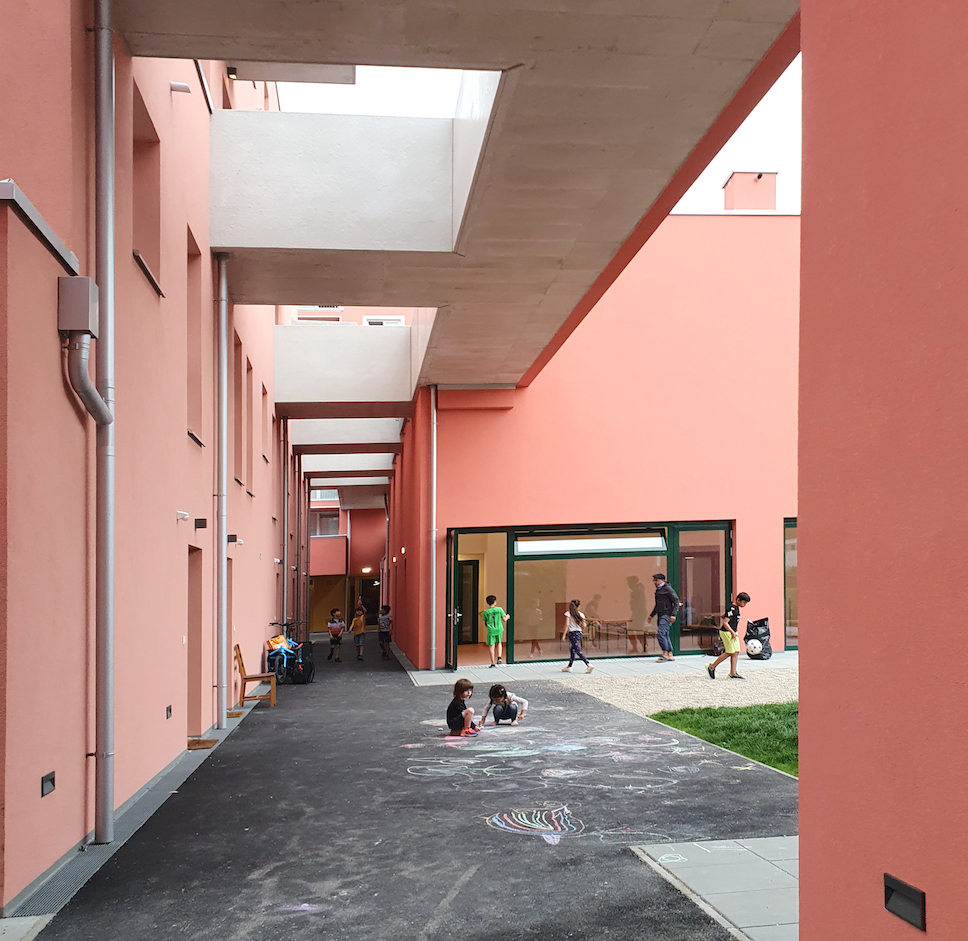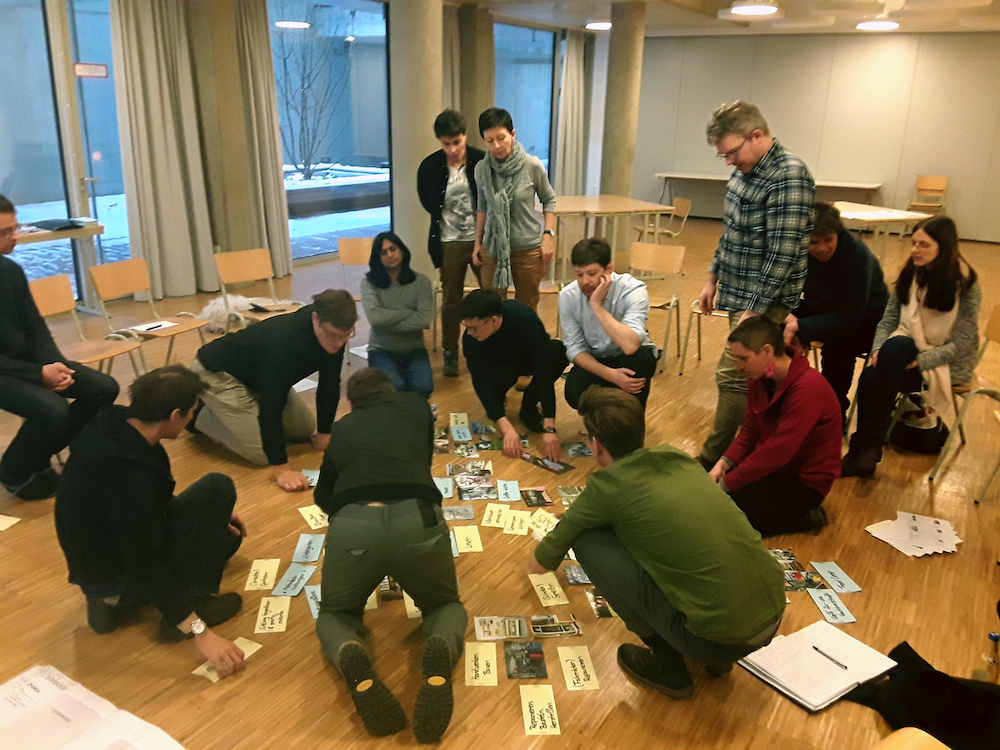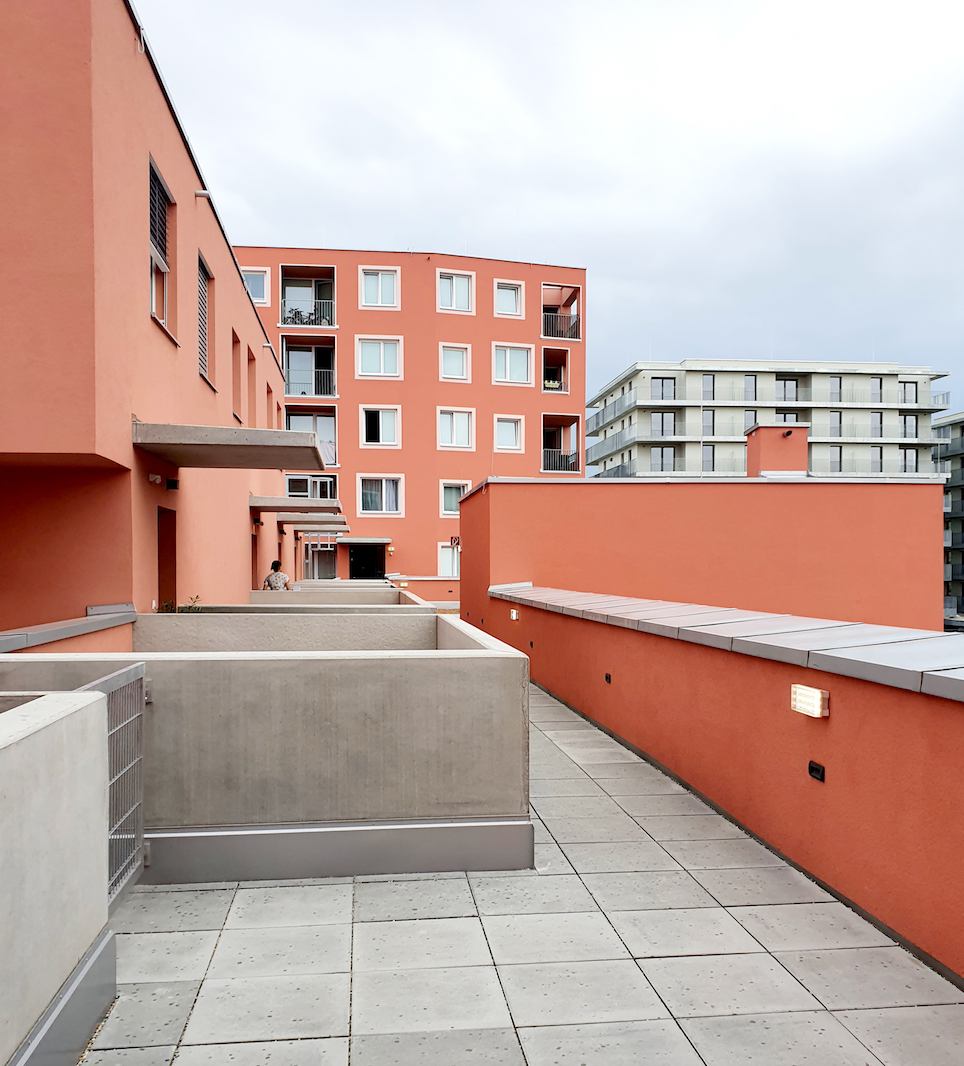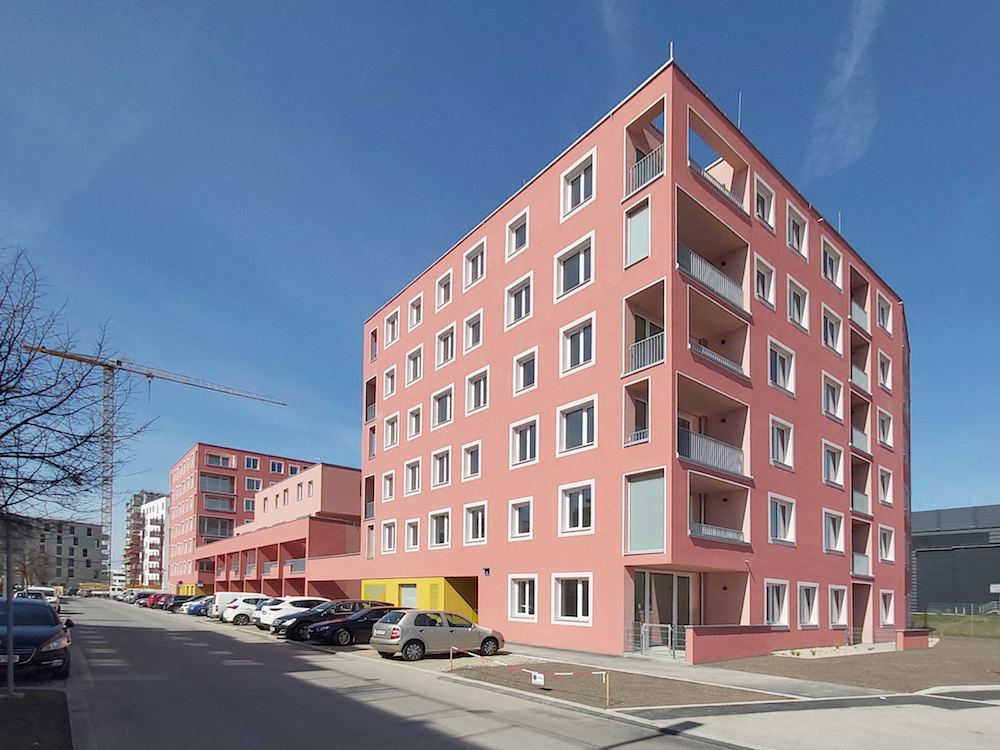wohnbund:consult is an independent office working in the field of social and sustainable urban developments with a focus on housing. Its interdisciplinary team focuses on urban and social housing issues as well as research projects, development and planning. In accordance with Vienna’s subsidised housing schemes, wohnbund:consult supported the development of the project OASE.inklusiv as part of a larger consortium. The purpose of this project is to provide affordable housing to newcomers who would normally be unable to afford and gain access to it.
We spoke with Ernst Gruber, a member of the management board of wohnbund:consult, and a former member of the Initiative Gemeinsam Bauen & Wohnen, the Austrian umbrella association for co-housing. Ernst’s research and work focus on spatial and urban research as well as on housing and participative processes. In this interview, Ernst gives an overview of the role of co-housing in Vienna’s housing market and introduces the co-housing project OASE.inklusiv, that holds inclusivity as one of its foundational ideals such as involving vulnerable groups like refugee families.
What role does co-housing play in Vienna’s housing market?
Co-housing is a niche sector in the Viennese housing market. The insights, experiences and lessons learned from a small group of housing units cannot be directly transferred to the general housing market. However, the process of co-housing is transparent and provides good insights into how the dynamics can work. There are two ways that co-housing projects can be materialised in Vienna: One way is to develop it through a private initiative, which is rare considering how expensive and difficult it is to find a plot in the overheated housing market. The second option is to apply as a collective of practitioners to a conceptual competition through which building plots are easier or sometimes explicitly accessible for co-housing projects. Such competitions create an overall higher quality in the built environment. Co-housing projects are expected to contribute to the larger neighbourhood, strengthening its identity, connectivity, and social dynamics.
In Vienna, co-housing projects developed in such a way have to meet the four pillars of the municipality’s quality measurement: architecture, ecology, economy, and social sustainability. Social sustainability as an aspect of integration is crucial for co-housing projects, as the participatory process requires multidimensional dialogues. Ownership of individual apartments is uncommon in co-housing projects. Usually, it is a semi-cooperative model, the so-called Wohnheim, where one owns a share of the house and is assigned an apartment.

How does the municipality of Vienna enable co-housing projects through planning regulations and zoning? Is there a coherent policy behind this support?
The organisation Initiative Gemeinsam Bauen & Wohnen (Collective Building) is an umbrella association, which I chaired for several years. One of its goals is to “improve the development conditions for communal forms of housing and to support the implementation of specific projects” through zoning. However currently there is no overall policy to support this goal. On a case-by-case basis, it is decided whether co-housing should play a role in the designated development areas i.e. through contribution to the planned development of a specific area or not. We have been seeing co-housing projects in various development areas of the city, for example in the inner-city developments such as brownfield development around the central railway station or former railway-owned plots. However, this is not a citywide strategy.
When the municipal administration decides to give funds and allocate land for co-housing it usually does so through conceptual competitions. Developers bring target groups into a new development area where they are engaged in the process of planning, financing, and organising themselves from the very beginning of the competition. Residents are not only concerned about the future building, but also about the neighbourhood in which they will live.
Participation processes are an essential part of both social housing managed by Wiener Wohnen and co-housing initiatives. What makes participation in co-housing projects unique?
We need to clarify what is meant by the participatory process. If we look at Wiener Wohnen’s social housing for example, the main goal is to provide affordable housing for a wide range of citizens, not to encourage engagement. Participatory processes play a bigger role in non-profit social or affordable housing developments to ensure that people get to know each other. In addition, many of such housing projects offer community spaces and amenities, such as multi-functional rooms for gatherings (i.e. birthday parties), indoor games or informal gatherings. In addition, they may include community spaces such as a sauna or outdoor areas. To get tenants to organise around these spaces there needs to be a participatory process.
Video about OASE.inklusiv. Produced by MICOLL (micoll.org), a partner of wohnbund:consult.
This differs from co-housing projects when it comes to the perspective of participation in decision-making: Here the future tenants are engaged in the design of their future residences from the beginning. Participation in co-housing projects refers to a fundamental aspect, namely the expectations and needs of future residents. After all, they are the decision-makers and can influence how the project is designed, conceived, organised, and managed.
What role does social integration play in social housing and co-housing?
Integration plays a major role in any housing project, regardless of its format and initiators. In most projects, a facilitation process is used to support social integration. In newly built housing complexes, an external organisation takes on the task of helping the new tenants reach consensus. In co-housing, communication, exchange and solidarity are at the core of the participation processes, so the integration potential is high. The integration process in co-housing projects strongly depends on how the project is organised and financed.
Co-housing increases residents’ connectivity with the common spaces and housing units as well as to the neighbourhood. Engagement occurs because people are involved in decision-making and can have an influence. In the co-housing projects in the “Sonnwendviertel” near the main train station, for example, independent solidarity actions were started during the war in Ukraine to find housing for people in need.
We’ve talked a lot about co-housing as a niche issue, but in general, integration isn’t a niche issue. It’s a general concern that’s to do with how we deal with democracy in our society. So, it shouldn’t be treated in a niche way. There should be a much broader understanding of integration.

How are co-housing projects financed?
Community housing projects rely on external funding sources. There are subsidised projects funded by the government, where housing projects as a whole can have a larger sum of money than individual applications. Another funding option is through a developer that has the knowledge and financial resources to fund the project. Essentially, the money is advanced, then the apartments are rented out either individually or for an entire group. As a result, the tenants pay back the loan taken out by the developer. Another alternative we see these days is the crowdfunding mechanism.
The solidarity network habiTAT, for example, facilitates such financing. It follows a cooperative-like strategy that also allows external people to participate in the financing. A Viennese example of this type of funding is Bikes and Rails.
What are the key elements of a co-housing project? What kind of professionals or stakeholders are needed?
A constellation consists of at least an architect and a group of future residents. If future residents need financial assistance, they should contact a developer. In addition, a facilitator, landscape architect, and consultants are needed to implement a housing project.
Co-housing can be approached in three different ways. One way is to offer a property and then ask a few people if they are interested in living there. In this way, a group of potential tenants is created. Second, a plan can be developed for a specific target group, such as queer individuals or single parents, etc. The third option is to include a group that chooses to live together. Usually, each project revolves around one of these three aspects.
How do housing subsidies work? Does the rent depend on the tenant’s income?
Based on the tenant’s incomes, about 80-85% of Viennese residents are entitled to subsidised housing but you still have to have equity capital to access. Further housing subsidies are subject to conditions and must be applied for. However tenants from the lowest income-segments can apply for flats with a lower equity capital demand. Such flats are allocated anonymously through the municipality, a process which can be very challenging for co-housing projects.

Participants in co-housing projects know each other personally from the beginning. Decisions are made jointly, but in the case of a subsidised co-housing project, one-third of the households are not known until they move in. This group of assigned tenants needs to be included in the principles of co-housing, which were developed without them.
When did the OASE project start, and what was the process like?
OASE.inklusiv started when we won a developer competition in 2015/16 for a new development in Vienna’s 22nd district. This area at the 22nd district has 70-80 units and there was a plot reserved for a co-housing project. We were contacted by an architectural firm that has extensive experience with co-housing projects in Austria. They also had a group of interested future tenants. We organised the process around their idea and eventually won the competition, which allowed us to realise this inclusive project.
In order to ensure that the target group of future tenants would have a place in this building, we collaborated with neunerHAUS, a Viennese association that takes care of people who have lost their homes and helps them to gain access to a new one. The association has extensive experience and the project was able to benefit intensively from this cooperation. From the very first moment, they were our intermediaries to speak for the future residents – the so-called newcomers.
OASE.inklusiv is subsidised by the municipality. This created a tight financial corset for the project, limiting available square meters, apartment sizes, etc… In order to implement a community housing project with the financial resources of affordable housing the architects had to determine in advance which decisions would be made by the future residents and which would be made by the architects.
In general, what decisions did the future residents of OASE make?
The main focus was on the urban plan and the arrangement of the building masses. The architects developed several floor plan scenarios. Each of these scenarios provided tenants or households with a set of different options. Furthermore, it is important to provide exceptions and individual arrangements. There was a clear understanding of how many spaces are reserved for communal use. The process determined where they should be located in the plan and their function.
How does the OASE project differ from other co-housing projects?
For the OASE project one-third of the flats were allocated by the City of Vienna. Those future tenants were chosen anonymously during the process as described earlier. There was no collaborative decision-making or selection of who fits better in the group. Whoever applied got a flat, it’s more of a first-come-first-served basis. Usually, this kind of anonymity is uncommon for co-housing projects.

Another third was formed by people who wanted to live in co-housing from the very beginning. Those tenants founded an association to organise themselves around it. NeunerHAUS represented the last group of future tenants. They allocated a certain number of flats to the target group from those tenants. In the end, we facilitated the process of communication between the different groups of future tenants and the developer.
In the OASE project, what governance mechanisms are in place to ensure regular participation? And what kinds of decisions can the community make together?
Tenants are organised within an association. They have a formal structure, procedures, and communication routines and are a decision-making body. They can propose who should move into the apartments next. The association can decide on the proposals. If someone moves out of the apartments managed by the housing cooperative members, they can propose a new tenant.
The association is responsible for communication with all tenants in the building. There are regular meetings and a clear decision-making process. These groups take care of specific projects with specific group members. They are organised by topics like the common areas, the garden, and communication in the house.
However, the procedure is different for the apartments managed by the municipality, and the association of apartment tenants has no say in the management of these apartments.
Were there conflicts between the groups in the OASE?
It is too early to speak of conflicts. In general, there are certain moments in the development of a house when the community comes together when there are conflicts. This kind of urge to communicate leads to a resilient community.
Currently, we can see how the community of future residents is developing. We have been with them for a long period of time. Now we have left them alone so as not to interfere with the dynamics of the group.
What are the main challenges for the OASE project?
One of the main challenges is to communicate the concept of the co-housing project to future tenants who aren’t familiar with it. In Vienna, co-housing is not very common, so we have to explain the concept within a short period of time.

Additionally, it usually takes three to four years from the beginning of the competition until the realisation phase. Therefore, naturally, the group of future residents changes their lifestyle or main focus of living, so accordingly, they drop out and new ones take their place. So then they need an introduction and we have to repeat the process of development and planning all over again.
It was difficult to convince the future residents to reserve a budget for their association to use in the common spaces. To have enough money to buy kitchen equipment, such as tables, chairs, and shelves. Usually, the construction phase gets more expensive than planned, which leaves an inadequate budget. Tenants do not have the time and money to think about this aspect. Ultimately, we came to an agreement by splitting the finances.
COVID-19 made the communication process confusing, as regular meetings in person were not possible. It was challenging for people who didn’t have a laptop with a camera or microphone. And then some of the tools that are being used in online communication were not accessible on mobile phones. Because of that, it was challenging to keep everyone on board and connected.
What can we learn from the OASE project regarding integration?
OASE benefits from working with other associations that have a rich experience with the integration process. OASE’s collaboration with neunerHAUS has been very successful. This is because they have worked with refugees and people who have lost their homes and have brought this experience to our process.
Are there any items on your ‘wishlist” to improve social integration in the housing market?
One of the things that would be on my wishlist is for market-based housing to contribute to the aspects of integration. There are many associations with positive ideas, and people who work in that sector. Possibly they just need to be brought together with political force, because without that it will not work.
Also, I think we do have a fundamental problem in Vienna: We see a growing demand for low-cost flats and on the other hand, growing offers of investor-driven, market-financed housing. The problem is we have a lot of requirements and high-quality standards for social and affordable housing and not as much for market-based housing. When you look at the competition brief for plots for affordable housing and requirements for subsidized housing, the general Request of proposal (RFP) is 44 pages long. This is because there are a lot of appendices and supporting documents that you have to include while respecting the four main selection criteria.
I also believe that the quality of social housing in Vienna is excellent because of the high standards that are set for it. It is still unclear to me why market-based housing cannot also be held accountable to a similar standard. I find these two housing fields are completely disconnected from each other. We have to put a lot of qualities and expectations on the social housing market, as well as apply the four pillars of quality assurance to market-based housing. Integration could then be executed throughout the city with a set number of apartments. This amount is managed by an organisation that is responsible for allocating these apartments to those in need.
When it comes to integration, what policy changes would we need?
I think that depends a lot on how you define integration. If you define integration based on what OASE does, then one idea would be to reserve 15% of the apartments for an association that gives apartments to a specific target group. So if you want to make integration visible in the city, it has to be in every corner of the housing estates.
If we go back to the 1920s, the city gave people who had nothing but were able to organise themselves plots of land and supported them to build for themselves. It is probably too simple to say that we repeat the same approach with people who want to settle down in Austria and build their village. We can, however, think about donating abandoned or empty buildings to those in need, for example. Bringing housing and integration together requires more thought.
Interview and article by Bana Saadeh.

